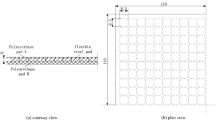Abstract
Existing forging processes have limitations in forming products with sharp edges. Therefore, a new hybrid-forming process that combines drawing and forging processes was designed to form a sharp-edged product. First, a corner radius of a preform design was arranged to be smaller than the minimum bent area corner radius formed in general drawing processes. Then, the shape of the preform was planned to have the exact shape of the final product. Given that forming loads are a limiting condition in forging processes, they were set as an evaluation criterion to determine design requirements for final product shapes and the shapes of preforms. The reliability of finite element analysis results was verified by comparing analysis and experiment results, and a multistage preforming process was implemented to satisfy the determined evaluation criterion. This study demonstrates that IT products with sharp edges can be formed.
Similar content being viewed by others
References
S. M. Hwang and S. Kobayashi, Preform design in disk forging, International Journal of Machine Tool Design and Research, 26 (1986) 231–243.
G. Zhao, Z. Zhao, T. Wang and R. V. Grandhi, Preform design of a generic turbine disk forging process, Journal of Materials Processing Technology, 84 (1998) 19–201.
D. C. Ko, D. H. Kim and B. M. Kim, Application of artificial neural network and Taguchi method to preform design in metal forging considering workability, International Journal of Machine Tools and Manufacture, 39 (1999) 771–785.
N. S. Biba, S. Stebounov and A. Lishiny, Cost effective implementation of forging simulation, Journal of Materials Processing Technology, 113 (2001) 34–39.
S. Roy, S. Ghosh and R. Shivpuri, A new approach to optimal design of multi-stage metal forming processes with micro genetic algorithms, International Journal of Machine Tools and Manufacture, 37 (1997) 29–44.
V. Vazquez and T. Altan, Die design for flashless forging of complex parts, Journal of Materials Processing Technology, 98 (2000) 81–89.
M. Zhan, Y. Liu and H. Yang, Influence of the shape and position of the preform in the precision forging of a compressor blade, Journal of Materials Processing Technology, 120 (2002) 80–83.
D. Shim and D. Yang, Multi-stage forming using optimized preform in the line array roll set process and its industrial application, International Journal of Precision Engineering and Manufacturing, 15 (2014) 2085–2092.
S. Badrinarayanan and N. Zabaras, A sensitivity analysis for the optimal design of metal-forming processes, Computer Methods in Applied Mechanics and Engineering, 129 (1996) 319–348.
A. Srikanth and N. Zabaras, Shape optimization and preform design in metal forming processes, Computer Methods in Applied Mechanics and Engineering, 190 (2000) 1859–1901.
X. Zhao, G. Zhao, G. Wang and T. Wang, Preform die shape design for uniformity of deformation in forging based on preform sensitivity analysis, Journal of Materials Processing Technology, 128 (2002) 25–32.
H. Shim, Optimal preform design for the free forging of 3D shapes by the sensitivity method, Journal of Materials Processing Technology, 134 (2003) 99–107.
M. Sedighi and S. Tokmechi, A new approach to preform design in forging process of complex parts, Journal of Materials Processing Technology, 197 (2008) 314–324.
W. H. Yang and Y. S. Tarng, Design optimization of cutting parameters for turning operations based on the Taguchi method, Journal of Materials Processing Technology, 84 (1998) 122–129.
A. R. Yildiz, A new design optimization framework based on immune algorithm and Taguchi's method, Computers in Industry, 60 (2009) 613–620.
W. Li, S. J. Hu and S.-W. Cheng, Robust design and analysis for manufacturing processes with parameter interdependency, Journal of Manufacturing Systems, 21 (2002) 93–100.
W. Rust and K. Schweizerhof, Finite element limit load analysis of thin-walled structures by ANSYS (implicit), LSDYNA (explicit) and in combination, Thin-Walled Structures, 41 (2003) 227–244.
K. Mori, S. Nishijima and C. J. Tan, Two-stage cold stamping of magnesium alloy cups having small corner radius, International Journal of Machine Tools and Manufacture, 49 (2009) 767–772.
H. Y. Kim, J. J. Kim and N. Kim, Physical and numerical modeling of hot closed-die forging to reduce forging load and die wear, Journal of Materials Processing Technology, 42 (1994) 401–420.
T. Y. Wang and C. Y. Huang, Improving forecasting performance by employing the Taguchi method, European Journal of Operational Research, 176 (2007) 1052–1065.
Y. Yanhui, L. Dong, H. Ziyan and L. Zijian, Optimization of Preform Shapes by RSM and FEM to Improve Deformation Homogeneity in Aerospace Forgings, Chinese Journal of Aeronautics, 23 (2010) 260–267.
Author information
Authors and Affiliations
Corresponding author
Additional information
Recommended by Editor Haedo Jeong
Hyunsoo Jeong received his B.S. degree from the Department of Mechanical Engineering, Sogang University, Seoul, South Korea in 2012. He received his M.S. degree from the Department of Mechanical Engineering, Sogang University, Seoul, South Korea in 2014. His research interests are shape manufacturing and computer-aided process analysis.
Naksoo Kim is currently a professor at the Department of Mechanical Engineering, Sogang University, Seoul, South Korea. He received his B.S. and M.S. degrees from the Department of Mechanical Design, Seoul National University, Seoul, South Korea in 1982 and 1984, respectively. He received his Ph.D. from UC Berkeley, California, USA. Dr. Kim has worked for the Engineering Research Center for Net Shape Manufacturing at Ohio State University as a senior researcher and at Hongik University as an assistant professor. Dr. Kim’s research interests are metal forming plasticity, computer-aided process analysis, and optimal design.
Rights and permissions
About this article
Cite this article
Jeong, H., Cheon, S., Hong, S. et al. Preform design of hybrid-forming process to make sheet metal IT products with a sharp edge. J Mech Sci Technol 29, 2467–2475 (2015). https://doi.org/10.1007/s12206-015-0541-z
Received:
Revised:
Accepted:
Published:
Issue Date:
DOI: https://doi.org/10.1007/s12206-015-0541-z




